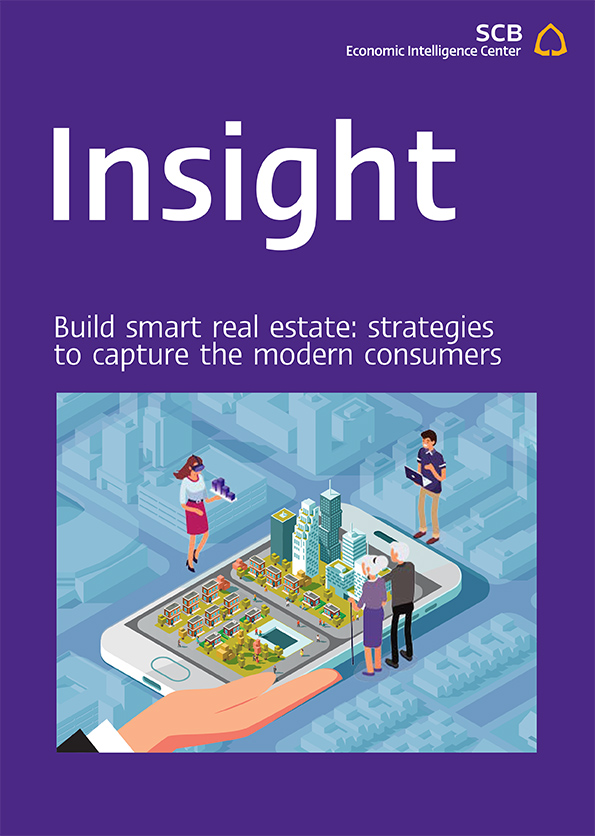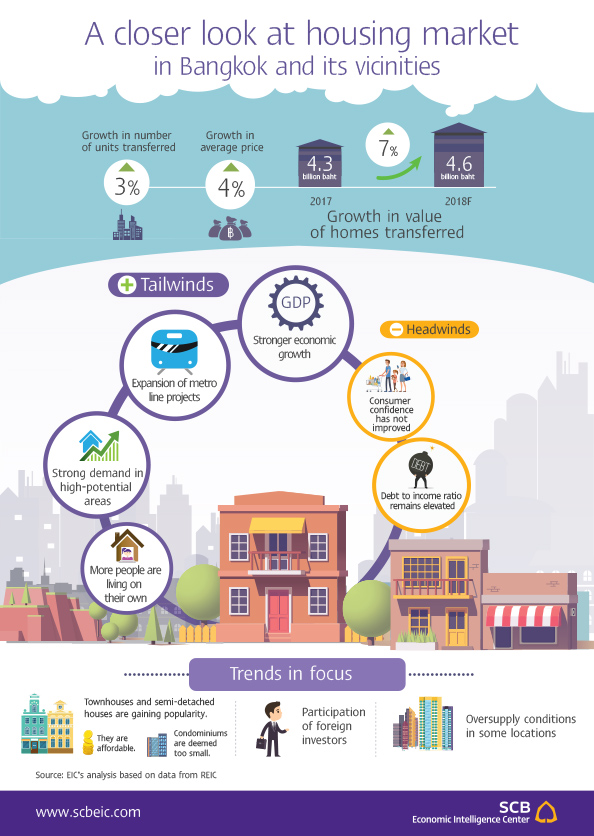Build smart real estate: strategies to capture the modern consumers
Residential housing market in Thailand will likely recover after having slowed down from the expiration of stimulus measures by the government, but the competition continues to intensify with rising number of unsold units. Nevertheless, residential transfers in Bangkok and its vicinities are projected to recover at around 7% in 2018 supported by an economic recovery, an expansion in transportation infrastructure, smaller household size, as well as demand for residentials in high potential locations which encouraged developers to continue launching residential projects and resulted in intensifying competition. However, developers need to be cautious in launching new projects and expedite in selling unsold units especially in the condominium market. Moreover, the market situation which currently depends on demand from home buyers becomes a difficult proposition for developers in developing new projects going forward.

Contents
- Executive Summary
- Chapter 1: Global trends in residential demand
- Chapter 2:Investigating home choices by Thais
- Chapter 3: Home marketing in the 4.0 age
Residential housing market in Thailand will likely recover after having slowed down from the expiration
of stimulus measures by the government, but the competition continues to intensify with rising
number of unsold units. Nevertheless, residential transfers in Bangkok and its vicinities are projected
to recover at around 7% in 2018 supported by an economic recovery, an expansion in transportation
infrastructure, smaller household size, as well as demand for residentials in high potential locations which
encouraged developers to continue launching residential projects and resulted in intensifying competition.
However, developers need to be cautious in launching new projects and expedite in selling unsold units
especially in the condominium market. Moreover, the market situation which currently depends on demand
from home buyers becomes a difficult proposition for developers in developing new projects going forward.
Different lifestyles of new generation consumers like the Millennials and consumers in an aging
society like the Baby Boomer, and consumption trends as well as technological innovation will all
influence the development and sales of residential projects in the future. EIC found that trends in
residential demand in Thailand to be monitored include 1) condominium market that will still dominate
the market although most buyers prefer low-rise residences 2) consumers that value having communal
areas, multiple functionalities of the project area, and green areas 3) consumers that prefer living close
to communities in addition to living close by the sky train 4) Smart home that will become the new
normal in the future and 5) consumers that will increasingly compare information from multiple digital
sources and prefer advanced visualization and presentation.
Although most Thai consumers prefer to live in low-rise residences in particular single-detached
houses, condominium will still dominate the market especially market for the new generation
entering the working age where condominium seems to be the most ideal choice given location and
purchasing power. Meanwhile, the Gen X and consumers in an aging society like the Baby Boomer also
prefer condominium to cater for various needs such as less burden on household chores, buying for
investment, while some are buying for their children. However, according to EIC’s survey, if there is not
much constraints, most consumers prefer to own low-rise residences.
Thai consumers give importance to residence with communal areas, functionality of the project area,
and green areas. Thai consumers place importance on the work-life balance, independent work-life and
are increasingly accepting social sharing. As a result, communal and shared areas in the residential project
increasingly affect residence purchasing decision. Thus, developers should consider the design with multiple
functionalities of the project area such as the co-working space and co-recreation in the residence as well
as areas that can accommodate sharing in other aspects in the future such as communal parking spaces.
Moreover, trends in demand for energy-saving residences with green areas have garnered much interests.
Convenient location close to the electric train remains important, but location close to communities
and facilities is no less important. Residential location close to the electric train and workplace may
not be sufficient to meet lifestyles of consumers. Consumers demand for necessities and facilities to be
closer to them, be they food and beverages, hospitals and healthcare centers, and department stores.
As a result, mixed used projects have gained much interests.
Technology has come to play a role in smart home. Although it is not yet popular in Thailand, but
its selling point earns much attention especially from the new generation. Meanwhile, the digital
channel will become the primary channel in reaching residential buyers, both in marketing and
after-sales services through new platforms. Smart home has become more popular, particularly for
its security system and energy management system in the residence. Moreover, consumers’ access to
technology offers the digital channel an increasing role in residential purchasing decision as consumers
increasingly compare information. Thus, developers should give importance to adopting prop tech to the
development of new platforms such as presentation on after-sale services in a range of styles, presentation
of information for consumers to easily compare among projects, and presentation of information in new
styles like AR or VR, as well as the adoption of prop tech as a tool to manage the project.
Intensifying competition in the residential market encouraged developers to focus on differentiation
strategies and deep understandings of consumers in order to enhance competitiveness. The 3 key
differentiation strategies to that should not be overlooked include 1) the design that mainly respond
to users’ demand such as the universal design that best satisfies the use by various groups of consumers.
Meanwhile, customized design will help differentiate developers from competitors to penetrate into the
niche market like the luxury market with higher potential to buy, 2) forming business partners to develop
new products, transfer knowledge, gain access to new buyers, and improve brand images. Business
partnership can occur in a variety of ways through, for example, joint venture with specialized experts
such as development of the mixed use project in the project with high potential where choices of real
estate compositions respond to the need of consumers from various groups. Moreover, it can also occur
though collaboration with start-ups to offer innovative technology in residences such as smart home, and
through forming partnership to improve brand images such as partnering with world’s leading chainedbrand
hotels which help add more value to the project, and 3) developing new after-sale platform
to increase sales opportunity and use Big data to improve products and services. Examples include
development of central platform that combines all after-sale services or the use of Big data that not only
helps reduce operating costs but also allow utilization of consumers’ behavior data or data on problems
arising from after-sale services to develop residential projects that meet consumer demand in the future.
